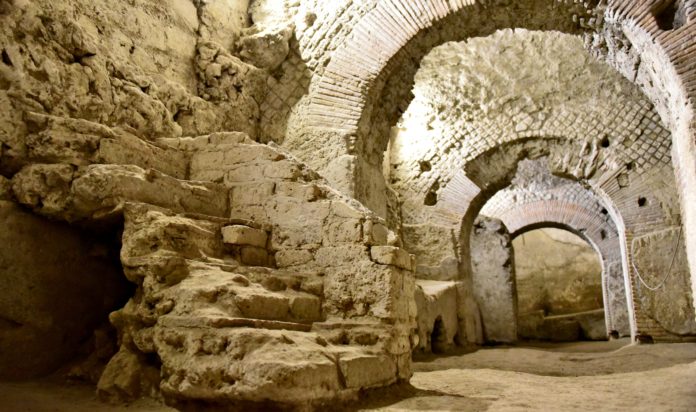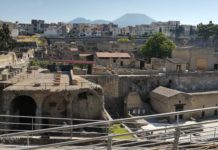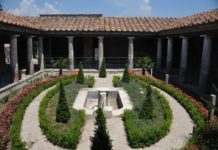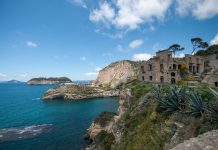Who wants to really understand the history of Naples and when it came it was and then follow how life is developed and grown to around Vesuvius can not miss these four archaeological sites. At least in our Charming. And for this we recommend you pay a visit to these four sites, of which below we present a small excerpt of their history from the main reference sites. The incredibility of places such as the archaeological excavations of the excavations in the monumental complex of San Lorenzo, in the very historical center of Naples, or the beauty of patrician villas like Villa Arianna and Villa San Marco, those on the Varano hill in Castellammare, and finally Oplonti better known as Villa di Poppea in the municipality of Torre Annunziata, will surely help you to know even more that past until today perhaps preserved thanks to a volcanic eruption. Villa Arianna .. “The ‘Villa Ariadne’, whose excavated area extends for about 2500 square meters, has a complex plant, and because the result of successive expansions, both because it adapts to the shape of the hill of which follows the trend. The ‘villa’, which is connected with the plain below through a series of ramps on six levels, is divided into four essential nuclei: the atrium and surrounding environments dating back to the late Republican age; service areas and spa; environments on either side of the summer dining room, dating back to Nero’s age; the close attention to the gym ‘villa’ Flavian.
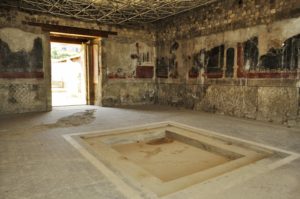
A long gallery, also starting from sottopassava ramps residential environments to arrive in the rustic part where there was access to the ‘house’ from the Varano plateau. The decorations not only witness to the high standard of living that was to take place here, but also the extremely refined taste of a high-ranking commission and demanding. “
Source: http://pompeiisites.org/stabiae/villa-san-marco“
The villa was built in the first Augustan age, only to be amended several times over the course of the first century A.D., particularly during Claudius. The visible structures were severely affected by the earthquake of 1980, which necessitated massive restoration. Currently you enter a vestibule that leads into the atrium, in which is placed the lararium, with fake marble decoration.
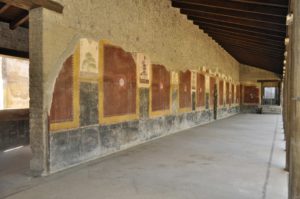
The area allocated to the baths attaches to the rest of the construction with a different axis, due to the presence of a road that has conditioned the orientation. The succession of environments is typical, which comprises a sequence frigidarium, tepidarium and caldarium respectively for the baths of cold water, warm and hot). A large portion of the surface of the villa is occupied, in addition, from the garden that stretches from a monumental nymphaeum, overlying an annular corridor and decorated with refined wall mosaics. The highest level is the fresco that decorates the diaeta (rest-room) at the end of the eastern side porch, with depiction of Perseus and Cassandra.” Source: Villa San Marco Oplonti – Villa di Poppea .. “The villa of” Poppea “, grandiose in size, quality of the frescoes and adorned with numerous sculptures in marble, was built around the middle of the first century BC and then enlarged in Claudian. It has been attributed to Poppea Sabina, the second wife of Emperor Nero, for the presence of a painted inscription on an amphora, addressed to Secundus, freedman of Poppea: in any case it had to belong to the rich heritage of the imperial family like many other members of the Roman nobility, he favored the Campania coast, famous in antiquity for the healthy climate and along which he loved to build sumptuous residential villas (otium villas).
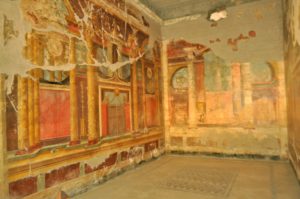
The Villa was uninhabited at the time of the eruption: in fact there was no furniture in the rooms, or pottery in the kitchen. Many found objects such as columns and lanterns, were set aside in a few rooms. Building Materials and work in progress show that in the Villa we were repairing the damage of one of the numerous earthquakes that struck frequently the Vesuvius area. ” Source: http://pompeiisites.org/stabiae/villa-san-marco/ Archaeological excavations Monumental Complex of San Lorenzo .. “The archaeological area, where are the ruins of the ancient Forum of Neapolis, is the most significant archaeological site present in the historic center of Naples, and for architectural and topographical value, both for its inclusion in the Angevin complex of San Lorenzo irregular Maggiore. The reservoir San Gaetano irregular square is what remains of a larger open area corresponding to the civil and religious center of the ancient city: this was in fact always recognized as the Roman era Forum, in turn coinciding with the ‘agora of the Greek city. ” Source: www.laneapolissotterrata.it/it/storia/

 Italiano
Italiano

